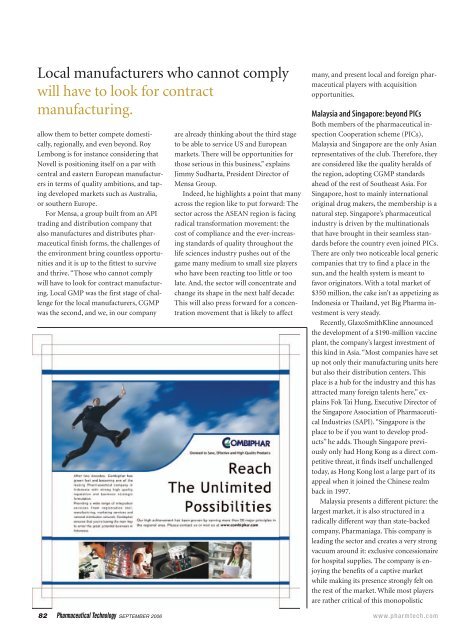An Executive Country Review: South East Asia An ... - EC Reviews
An Executive Country Review: South East Asia An ... - EC Reviews
An Executive Country Review: South East Asia An ... - EC Reviews
You also want an ePaper? Increase the reach of your titles
YUMPU automatically turns print PDFs into web optimized ePapers that Google loves.
Local manufacturers who cannot comply<br />
will have to look for contract<br />
manufacturing.<br />
allow them to better compete domestically,<br />
regionally, and even beyond. Roy<br />
Lembong is for instance considering that<br />
Novell is positioning itself on a par with<br />
central and eastern European manufacturers<br />
in terms of quality ambitions, and taping<br />
developed markets such as Australia,<br />
or southern Europe.<br />
For Mensa, a group built from an API<br />
trading and distribution company that<br />
also manufactures and distributes pharmaceutical<br />
finish forms, the challenges of<br />
the environment bring countless opportunities<br />
and it is up to the fittest to survive<br />
and thrive. “Those who cannot comply<br />
will have to look for contract manufacturing.<br />
Local GMP was the first stage of challenge<br />
for the local manufacturers, CGMP<br />
was the second, and we, in our company<br />
are already thinking about the third stage<br />
to be able to service US and European<br />
markets. There will be opportunities for<br />
those serious in this business,” explains<br />
Jimmy Sudharta, President Director of<br />
Mensa Group.<br />
Indeed, he highlights a point that many<br />
across the region like to put forward: The<br />
sector across the ASEAN region is facing<br />
radical transformation movement: the<br />
cost of compliance and the ever-increasing<br />
standards of quality throughout the<br />
life sciences industry pushes out of the<br />
game many medium to small size players<br />
who have been reacting too little or too<br />
late. <strong>An</strong>d, the sector will concentrate and<br />
change its shape in the next half decade:<br />
This will also press forward for a concentration<br />
movement that is likely to affect<br />
many, and present local and foreign pharmaceutical<br />
players with acquisition<br />
opportunities.<br />
Malaysia and Singapore: beyond PICs<br />
Both members of the pharmaceutical inspection<br />
Cooperation scheme (PICs),<br />
Malaysia and Singapore are the only <strong>Asia</strong>n<br />
representatives of the club. Therefore, they<br />
are considered like the quality heralds of<br />
the region, adopting CGMP standards<br />
ahead of the rest of <strong>South</strong>east <strong>Asia</strong>. For<br />
Singapore, host to mainly international<br />
original drug makers, the membership is a<br />
natural step. Singapore’s pharmaceutical<br />
industry is driven by the multinationals<br />
that have brought in their seamless standards<br />
before the country even joined PICs.<br />
There are only two noticeable local generic<br />
companies that try to find a place in the<br />
sun, and the health system is meant to<br />
favor originators. With a total market of<br />
$350 million, the cake isn’t as appetizing as<br />
Indonesia or Thailand, yet Big Pharma investment<br />
is very steady.<br />
Recently, GlaxoSmithKline announced<br />
the development of a $190-million vaccine<br />
plant, the company’s largest investment of<br />
this kind in <strong>Asia</strong>. “Most companies have set<br />
up not only their manufacturing units here<br />
but also their distribution centers. This<br />
place is a hub for the industry and this has<br />
attracted many foreign talents here,” explains<br />
Fok Tai Hung, <strong>Executive</strong> Director of<br />
the Singapore Association of Pharmaceutical<br />
Industries (SAPI). “Singapore is the<br />
place to be if you want to develop products”<br />
he adds. Though Singapore previously<br />
only had Hong Kong as a direct competitive<br />
threat, it finds itself unchallenged<br />
today, as Hong Kong lost a large part of its<br />
appeal when it joined the Chinese realm<br />
back in 1997.<br />
Malaysia presents a different picture: the<br />
largest market, it is also structured in a<br />
radically different way than state-backed<br />
company, Pharmaniaga. This company is<br />
leading the sector and creates a very strong<br />
vacuum around it: exclusive concessionaire<br />
for hospital supplies. The company is enjoying<br />
the benefits of a captive market<br />
while making its presence strongly felt on<br />
the rest of the market. While most players<br />
are rather critical of this monopolistic<br />
82 Pharmaceutical Technology SEPTEMBER 2006 www.pharmtech.com


